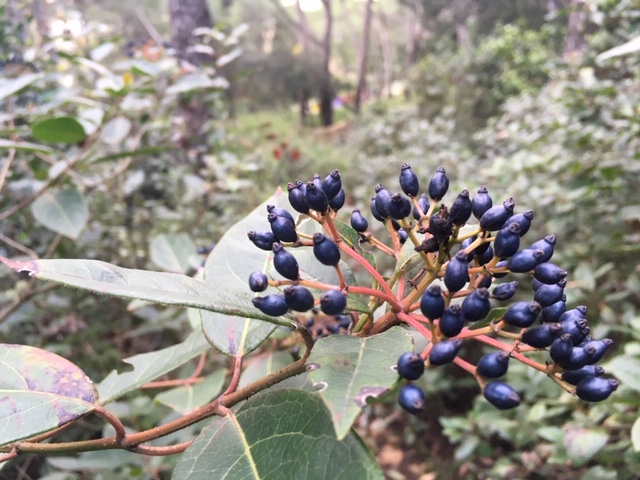
Gardenias, geckos and the sixth extinction
Each day here I am surprised and charmed by a new plant, flower, seed, or animal. Figs, olives, cactus, geckos, herons, red chipmunks, passionflowers, hawthorns… I can smell the biodiversity of this place. Thick, pungent smells of pines and roses and cedars hit me when I walk through the park and streets, and whiffs of something gardenia-like are enough to make a person swoon. This sense of abundant plant and animal life must be partly because this ecosystem is new to me, but the quantity and diversity of species here is striking. It turns out that this part of France is one of the world’s biodiversity hotspots, along with the whole Mediteranean Basin, the Amazon and Madagascar.

Arbutus unedo (arbusier or strawberry tree) is a funky, colourful bush decorated with orange balls and white bells
But underneath this teeming, wafting, chirping life lies a staggering global decline in biodiversity. I knew this, I know this, but some recent readings have brought it into a new light.
La Terre et les Hommes is a compilation of works by the great Hubert Reeves, an astrophysicist with one foot in Quebec and the other in France. I stumbled across this book on one of my pilgrimages to the Sète community library (or Médiathèque, as they call them here — which makes me worry that the end of books is nigh…). I have to admit that I’m an impatient reader of scenery descriptions — in novels I skim those parts to get to the action. But there’s something so genuine, so naïvely appreciative, about the way he describes his beloved village of Malicorne in Bourgogne (France) that hooks me:
Dans cette campagne grasse, verdoyante, légèrement vallonnée, on peut marcher des heures sans rencontrer une seule voiture. C’est un lieu ou il faut enlever sa montre et s’insérer dans le rythme de la nature dont la vie moderne nous coupe si cruellement. L’odeur des fleurs d’acacias ou de tilleuls y marque le printemps et l’apparition des mauves colchiques dans les prés humides nous annonce, mine de rien, que l’automne est déjà là.
Loose translation: In this rich, green, slightly hilly countryside, you can walk for hours without meeting a single car. It is a place that calls you to take off your watch and integrate yourself into the rhythm of nature, from which modern life so cruelly cuts us off. The smell of acacia or linden tree blossoms marks the presence of spring and the appearance of purple crocuses in damp meadows quietly announces that autumn is already upon us.
Lovely, right? Makes me want to hole up in Malicorne for a week (I googlemapped it: a four-hour drive, 31 hour bike ride, or 3 regional trains would get me there…). Appreciation of the poetry of nature goes alongside a broad and deep scientific knowledge in this man’s work. He strolls through the history of human understanding of the world, from mathematics to physics, chemistry, biology and psychology, like the rest of us would take a walk in the park. Equally well documented is the story of our myriad terrible impacts on the planet — notably biodiversity loss.
In the popular masterpiece Sapiens, Yuval Noah Harari describes three ‘waves’ of human-caused extinction. The first wave accompanied the spread of foragers (with the Cognitive Revolution 70 000 years ago); the second with the advent of farmers, and the third with industrial activity. While these waves happened at different times across the planet, it’s clear that wherever homo sapiens settled in a new part of the world, mass extinctions followed. Well before inventing the wheel, writing or iron tools, Harari explains, humans drove about half of the planet’s big beasts to extinction.
During the fifth great extinction 65 million years ago, Reeves reminds us, a giant meteorite struck the Yucatan in Mexico. It led to the disappearance of some 76% of all species, including all land-based dinosaurs. We’re now in the middle of the sixth great extinction, part of a geological period called the Holocene which began after the last major ice age ended some 12 thousand years ago. Dramatic biodiversity declines correspond with the very rapid growth, spread and impact of the human species – so much that it is coming to be known as the Anthropocene. A recent study published in the Proceedings of the National Academies of Science found that between 1900 and 2015, close to half of the 177 mammal species surveyed lost more than 80% of their habitat range, calling it a ‘biological annihilation’.

The extinct Pig-footed bandicoot
from Mammals of Australia
And it’s not over. The 2019 Global Assessment Report on Biodiversity and Ecosystem Services estimates that some one million species of plants and animals face extinction from anthropogenic impacts. These declines are, of course, driven by ongoing human population growth and high consumption.
In one of my all-time favorite articles, Leverage Points to Intervene in a System by Donella Meadows, she lists leverage points to intervene in a system in decreasing order of powerfulness. Third from the top, just behind changing paradigms and transcending them, is changing the high-level goals of the system. For example, she says, ‘in ecosystems, the goal of keeping populations in balance and evolving has to trump the goal of each population to reproduce without limit and control all the resource base’. This is why in the Drawdown global list of eighty top climate actions, educating girls and family planning are solutions number 6 and 7, in recognition of the impact that balancing human populations has on planetary well-being.
The million euro question is how to change the high-level goals of the system…